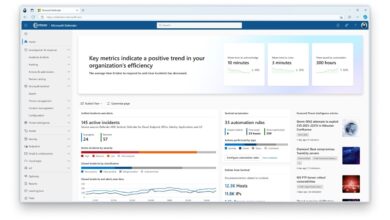
How Companies Should Recover When Password Breach Occurs
How companies should recover when password breach occurs is a critical question facing every organization in today’s digital landscape. A single breach can unravel years of hard work, damaging reputation, eroding customer trust, and incurring significant financial losses. But it’s not just about damage control; it’s about learning, adapting, and emerging stronger. This isn’t a simple checklist; it’s a journey that requires careful planning, swift action, and a commitment to robust security practices.
Let’s explore the steps involved in navigating this complex situation.
From immediate containment and user notification to forensic investigation and long-term security enhancements, the response to a password breach demands a multi-faceted approach. We’ll delve into the legal and regulatory obligations, the importance of transparent communication, and the crucial role of reputation management. Ultimately, recovering from a breach isn’t just about fixing the immediate problem; it’s about building a more resilient security posture for the future.
Immediate Response and Containment
A password breach is a critical incident demanding immediate and decisive action. The speed and effectiveness of your initial response directly impact the extent of damage and the overall recovery process. Failure to act swiftly and decisively can lead to significant financial losses, reputational damage, and legal repercussions. The first hour is crucial, and a well-defined plan is essential for minimizing the fallout.The initial steps involve a rapid assessment of the situation, followed by immediate actions to secure systems and prevent further unauthorized access.
This requires a coordinated effort across multiple teams, with clear communication channels to ensure everyone is informed and working towards the same goal. A well-rehearsed incident response plan, tested regularly, is vital for effective action during such crises.
Securing Systems and Preventing Further Unauthorized Access
Once a password breach is confirmed, the immediate priority is to contain the damage and prevent further unauthorized access. This involves several crucial steps, starting with isolating affected systems. This might involve temporarily shutting down affected servers or networks to limit the breach’s impact. Simultaneously, you should initiate a thorough investigation to determine the scope of the breach—which systems were compromised, what data was accessed, and how the breach occurred.
This involves reviewing logs, analyzing network traffic, and potentially engaging forensic experts. Password resets for all affected accounts should be mandatory, and multi-factor authentication (MFA) should be immediately enforced wherever possible. Furthermore, temporary access restrictions should be applied to affected accounts while investigations are ongoing.
Initial Actions Checklist (First Hour)
The first hour following the discovery of a password breach is critical. A structured checklist can help ensure that crucial steps are not overlooked during this high-pressure period.
This checklist prioritizes actions based on urgency and impact, ensuring a rapid and effective response. Remember, time is of the essence.
- Confirm the Breach: Verify the breach and its scope. Gather initial evidence.
- Isolate Affected Systems: Immediately disconnect compromised systems from the network to prevent further spread.
- Activate Incident Response Team: Assemble the designated team and clearly define roles and responsibilities.
- Begin Investigation: Start logging all actions and initiate a forensic investigation if necessary.
- Implement Emergency Password Reset: Force password resets for all potentially affected accounts.
- Enable MFA (if not already in place): Immediately enforce multi-factor authentication wherever possible.
- Notify Relevant Stakeholders: Inform key personnel within the organization, including legal and PR teams.
Internal Communication Plan
Effective communication is paramount during a password breach response. A clear communication plan helps to coordinate efforts, keep everyone informed, and minimize confusion and panic.
The plan should define communication channels, frequency of updates, and designated spokespeople. Transparency and timely information are essential to maintain morale and trust.
| Team | Communication Method | Frequency | Information Shared |
|---|---|---|---|
| Incident Response Team | Dedicated Slack channel, email | Real-time updates | Technical details, progress reports, action items |
| IT Staff | Email, internal announcements | Hourly updates | System status, security measures implemented |
| Executive Team | Regular briefings | Every 2-3 hours | High-level overview, potential impact, strategy |
| Employees | Email, company intranet | As soon as possible, followed by regular updates | Information about the breach, steps taken, and advice for protecting personal accounts. |
User Notification and Support

A password breach is a serious event, and how you handle user notification and support can significantly impact your company’s reputation and the trust your customers place in you. Transparency, empathy, and swift action are key to mitigating the damage and rebuilding confidence. Failing to communicate effectively can lead to further distrust and potential legal ramifications.A well-defined plan for user notification and support should be in placebefore* a breach occurs.
This plan should detail the communication strategy, the support offered, and the process for handling user inquiries.
Sample Email Template for Affected Users
Subject: Important Information Regarding Your [Company Name] Account SecurityDear [User Name],We are writing to inform you of a recent security incident that may have affected your [Company Name] account. On [Date], we discovered unauthorized access to our systems, potentially compromising certain user data, including [specify data compromised, e.g., usernames, email addresses, passwords]. We are taking this matter very seriously and have already taken steps to secure our systems and prevent further incidents.To protect your account, we strongly recommend you immediately change your password and enable two-factor authentication if available.
You can do so by visiting [link to password reset page].We understand this news may be concerning, and we sincerely apologize for any inconvenience or anxiety this may cause. To further assist you, we are offering complimentary credit monitoring services through [Name of Credit Monitoring Service] for [Duration of service]. You can access this service by visiting [link to credit monitoring service].If you have any questions or concerns, please do not hesitate to contact our dedicated support team at [phone number] or [email address].Sincerely,The [Company Name] Team
Best Practices for Communicating with Users
Effective communication during a data breach requires transparency, empathy, and clear, concise language. Avoid technical jargon and focus on providing users with the information they need to understand the situation and take appropriate steps to protect themselves. Acknowledging the inconvenience and expressing sincere apologies can go a long way in building trust. Regular updates should be provided to keep users informed of the ongoing investigation and remediation efforts.
A dedicated FAQ section on your website can also help address common concerns.For example, instead of saying “Our systems experienced a compromise,” you could say “We recently discovered unauthorized access to our systems, which may have affected some of your personal information.” The latter is clearer and more empathetic.
Types of Support Offered to Affected Users
Offering robust support is crucial for demonstrating your commitment to user security and regaining trust. This support should go beyond simply informing users of the breach. Consider the following:
- Credit Monitoring Services: Providing free credit monitoring for a specified period allows users to monitor their credit reports for any suspicious activity.
- Identity Theft Protection: This comprehensive service helps users recover from identity theft, including assistance with legal and financial matters.
- Dedicated Support Line: A dedicated phone line and email address staffed by knowledgeable personnel can provide immediate answers to user queries and concerns.
- Regular Updates: Providing regular updates on the investigation and remediation efforts demonstrates transparency and keeps users informed.
- Security Recommendations: Offering guidance on best practices for online security, such as password management and phishing awareness, empowers users to protect themselves in the future.
User Support Process Flowchart
The following flowchart illustrates a typical user support process following a data breach:
| Stage | Action | Responsible Party | Timeline |
|---|---|---|---|
| Initial Contact | User contacts support via phone, email, or website. | Customer Support Team | Immediate |
| Verification | User identity is verified. | Customer Support Team | Within 24 hours |
| Information Provision | User is provided with information about the breach and support options. | Customer Support Team | Within 24 hours |
| Issue Resolution | Support team addresses user concerns and provides assistance. | Customer Support Team & Specialized Teams (if needed) | Within 48-72 hours |
Forensic Investigation and Root Cause Analysis
A password breach isn’t just about patching the immediate hole; it’s about understanding how it happened and preventing future attacks. A thorough forensic investigation is crucial for this, going beyond simply restoring systems. It’s about learning from the experience and strengthening security for the long term. This involves a meticulous process of data collection and analysis to identify the extent of the compromise, pinpoint the root cause, and ultimately, inform the development of robust preventative measures.The goal of a forensic investigation after a password breach is to reconstruct the timeline of events, identify the attacker’s methods, and determine the full scope of the compromised data.
This process requires specialized tools and expertise to ensure a comprehensive and accurate understanding of what occurred. Failure to conduct a thorough investigation leaves the organization vulnerable to future attacks and can result in significant legal and financial repercussions.
Data Acquisition and Preservation
The first step involves securing all potentially compromised systems and data. This includes isolating affected servers, workstations, and network devices to prevent further data exfiltration. Then, forensic images of hard drives, memory, and network logs must be created. These images are exact copies of the original data, ensuring the integrity of the evidence. The chain of custody must be meticulously documented at every stage to maintain the admissibility of the evidence in any potential legal proceedings.
For example, every person who handles the evidence should be recorded, along with the date and time of access.
Network Traffic Analysis
Examining network logs and traffic data is vital for identifying the entry point and the attacker’s activities within the network. This includes analyzing logs from firewalls, intrusion detection systems (IDS), and routers. The investigation will focus on identifying unusual network activity, such as unauthorized login attempts, data exfiltration patterns, and suspicious connections to external IP addresses. For instance, investigators might find unusually high volumes of data being transferred to a specific IP address outside the organization’s network, indicative of data exfiltration.
System Log Analysis
Analyzing system logs from compromised machines reveals details about the attacker’s actions, such as commands executed, files accessed, and accounts compromised. This includes examining Windows event logs, systemd journal logs (for Linux systems), and application-specific logs. Investigators might find evidence of malware execution, unusual user activity, or attempts to escalate privileges. For example, a log might show a user account with limited privileges suddenly accessing system-level files, indicating a possible privilege escalation attack.
Malware Analysis
If malware is suspected, a detailed analysis of the malicious software is necessary to understand its capabilities, functionality, and infection vector. This might involve reverse engineering the malware to determine how it operates and identify any communication channels used by the attacker. Analyzing the malware’s code can reveal details about its origin, its purpose, and any other systems it may have infected.
For example, the malware might be communicating with a command-and-control server, revealing the attacker’s location or infrastructure.
Vulnerability Assessment
A thorough vulnerability assessment is crucial to identify weaknesses exploited by the attacker. This involves scanning systems for known vulnerabilities, checking for outdated software, and assessing the effectiveness of existing security controls. For instance, the assessment might reveal that the organization was using outdated versions of software with known vulnerabilities that were exploited by the attacker. This step is crucial in identifying the specific vulnerabilities that need to be addressed to prevent future breaches.
Password Reset and Security Enhancement
A password breach necessitates more than just containing the immediate damage; it demands a comprehensive overhaul of security protocols. This involves not only resetting compromised passwords but also implementing robust measures to prevent future incidents. A secure and well-designed password reset process, coupled with enhanced security features, is crucial for regaining user trust and fortifying the company’s digital defenses.
The aftermath of a breach presents a critical opportunity to strengthen security posture. Failing to capitalize on this moment increases vulnerability to future attacks. A multi-pronged approach, encompassing improved password management, enhanced authentication, and regular security audits, is essential for long-term protection.
Secure Password Reset Process Design
Designing a secure password reset process requires careful consideration of several factors. The process should be user-friendly while maintaining robust security. This includes employing strong password complexity requirements, enforcing unique passwords across different accounts, and implementing multi-factor authentication (MFA) wherever possible. The system should also provide options for account recovery without compromising security, such as using trusted devices or recovery email addresses.
A well-designed process should guide users through a series of verification steps, preventing unauthorized access even if the password is compromised. For example, a combination of a one-time code sent via SMS or email, coupled with answering security questions, significantly enhances the security of the password reset process.
Security Enhancements to Prevent Future Breaches
Implementing a range of security enhancements is vital for minimizing the risk of future breaches. These enhancements should be viewed as layers of defense, working together to protect sensitive data.
The following security enhancements should be considered:
- Multi-Factor Authentication (MFA): MFA adds an extra layer of security by requiring users to provide multiple forms of authentication, such as a password and a one-time code from a mobile app or email. This significantly reduces the risk of unauthorized access even if a password is stolen. For instance, requiring both a password and a code from a Google Authenticator app would make unauthorized access significantly more difficult.
- Password Managers: Password managers generate and store strong, unique passwords for each online account, eliminating the need for users to remember complex passwords. They also offer features such as password audits and breach monitoring, further enhancing security. Popular examples include LastPass, 1Password, and Bitwarden.
- Regular Security Audits: Regular security audits, conducted by internal or external security experts, identify vulnerabilities in systems and processes. These audits should encompass network security, application security, and employee security awareness training. Regular audits allow for proactive identification and remediation of vulnerabilities before they can be exploited by attackers. A yearly audit is a good starting point, with more frequent audits for systems handling highly sensitive data.
Comparison of Password Management Strategies
Several strategies exist for managing passwords, each with its own strengths and weaknesses.
Here’s a comparison of different approaches:
| Strategy | Strengths | Weaknesses |
|---|---|---|
| Individual Password Management | Simple to implement (initially) | Prone to weak and reused passwords; difficult to manage many accounts; high risk of compromise. |
| Password Managers | Generates strong, unique passwords; centralizes password storage; often includes security features like breach monitoring. | Requires trust in the password manager provider; potential single point of failure if the master password is compromised. |
| Company-Wide Password Policy Enforcement | Enforces strong password requirements across the organization; improves overall security posture. | Can be inconvenient for users if too restrictive; requires technical implementation and enforcement. |
Implementation of Stronger Password Policies
Implementing stronger password policies is a critical step in improving overall security. These policies should mandate the use of complex passwords, including a minimum length, a mix of uppercase and lowercase letters, numbers, and symbols. Regular password changes should also be enforced, along with policies that prevent the reuse of old passwords. Consider implementing a password complexity scoring system to guide users towards stronger passwords.
For example, a policy could require passwords to be at least 12 characters long, containing at least one uppercase letter, one lowercase letter, one number, and one special character. Regular password rotations, perhaps every 90 days, further enhance security. The company should also provide tools and resources to help users create and manage strong passwords, such as password managers.
Legal and Regulatory Compliance
A password breach isn’t just a technical problem; it’s a legal and regulatory minefield. Failing to navigate this terrain correctly can lead to significant financial penalties, reputational damage, and even criminal charges. Understanding and adhering to relevant laws and regulations is paramount to mitigating these risks and ensuring a responsible response to a security incident.Data breach notification laws vary significantly by jurisdiction, but they all share a common thread: the requirement to inform affected individuals and, in many cases, regulatory bodies about a security incident involving personal data.
These laws often dictate specific timelines for notification, the information that must be included in the notification, and the methods used to contact affected individuals. The penalties for non-compliance can be substantial, ranging from fines to lawsuits.
Data Breach Notification Laws
Data breach notification laws are enacted at both the state and federal levels in many countries. For example, in the United States, numerous states have their own specific data breach notification laws, often requiring notification within a timeframe of 30 to 60 days of discovery. The California Consumer Privacy Act (CCPA) and the California Privacy Rights Act (CPRA) are particularly stringent, outlining comprehensive requirements for data security and breach notification.
The European Union’s General Data Protection Regulation (GDPR) sets a high bar for data protection across the entire EU, requiring notification within 72 hours of becoming aware of a breach. These laws often define what constitutes “personal data,” which typically includes names, addresses, social security numbers, and financial information. Failure to comply with these notification requirements can result in significant fines and legal action.
Reporting a Breach to Relevant Authorities
The process of reporting a breach to relevant authorities also varies depending on the jurisdiction and the nature of the data involved. In some cases, notification is mandatory; in others, it’s advisable to proactively inform authorities even if not legally required. Typically, this involves contacting the relevant data protection authority or law enforcement agency. The report should include details about the breach, the number of individuals affected, the types of data compromised, and the steps taken to mitigate the damage.
So, your company’s been hit with a password breach? Ugh, the worst. First things first: immediately reset all passwords and implement multi-factor authentication. Building robust, secure systems is key, and that’s where learning more about efficient development comes in, like exploring the innovative approaches discussed in this article on domino app dev the low code and pro code future.
Understanding these modern development techniques can help prevent future breaches and streamline your recovery process. Remember, thorough employee training on security best practices is also crucial for long-term protection.
Maintaining meticulous records of all communication and actions taken is crucial for demonstrating compliance and mitigating potential liability. For example, in the US, depending on the nature of the data involved, agencies such as the Federal Trade Commission (FTC) or state attorneys general may be involved. Under GDPR, the relevant supervisory authority in the EU member state where the company has its main establishment or where the breach occurred must be notified.
Potential Legal Liabilities
Companies facing a password breach can face a range of legal liabilities, including class-action lawsuits from affected individuals, regulatory fines, and even criminal charges. These liabilities can stem from violations of data breach notification laws, failure to implement reasonable security measures, and breaches of contract or other legal obligations. The severity of these liabilities depends on several factors, including the nature of the data compromised, the number of individuals affected, the company’s negligence, and the applicable laws.
For instance, a company that fails to implement adequate security measures, leading to a significant data breach, could face substantial financial penalties and reputational damage. Furthermore, if the breach involves sensitive personal information such as medical records or financial data, the potential legal consequences can be even more severe.
Best Practices for Legal and Regulatory Compliance
Proactive measures are key to minimizing legal risk. Implementing a comprehensive data security program that includes regular security assessments, employee training, and incident response planning is crucial. This includes establishing clear procedures for data breach notification, maintaining detailed records of security incidents, and cooperating fully with investigations. Regularly reviewing and updating security policies and procedures to align with evolving legal and regulatory requirements is also essential.
Establishing a strong data governance framework, including data minimization and purpose limitation principles, can significantly reduce the risk of legal repercussions following a breach. Finally, engaging with legal counsel specializing in data security and privacy law is highly recommended to ensure compliance and to navigate the complexities of data breach response.
Reputation Management and Public Relations: How Companies Should Recover When Password Breach Occurs

A password breach isn’t just a technical problem; it’s a PR crisis. How your company responds in the immediate aftermath and the following weeks will significantly impact your brand’s reputation and customer loyalty. Swift, transparent, and empathetic communication is crucial to mitigating the damage and rebuilding trust.A proactive and well-defined communication strategy is essential for navigating the turbulent waters of a data breach.
This strategy must encompass all stakeholders – customers, employees, investors, and the media – ensuring consistent messaging and a unified front. Failure to do so can amplify negative perceptions and lead to irreparable damage.
Communication Strategy for Addressing the Breach
The initial communication should be concise, factual, and acknowledge the breach directly. Avoid jargon and technical terms. Emphasize the steps being taken to address the situation, protect affected individuals, and prevent future occurrences. A multi-channel approach is recommended, using press releases, website updates, social media posts, and direct email notifications to affected users. The messaging should be consistent across all platforms.
For example, a press release could Artikel the scope of the breach, the number of affected individuals, the type of data compromised, and steps taken to mitigate the risk. This should be followed up by emails to affected individuals with more specific information and resources. Social media should be monitored closely for public sentiment and questions, with prompt and helpful responses.
Mitigating the Negative Impact on Reputation
Reputation repair after a breach requires a multi-pronged approach. This includes taking immediate steps to secure systems, actively cooperating with law enforcement investigations, and demonstrating genuine remorse and commitment to regaining customer trust. Proactive measures, such as offering credit monitoring services to affected customers, can significantly soften the blow. Transparency is paramount; hiding information or downplaying the severity of the situation will only exacerbate the damage.
Consider engaging a PR firm specializing in crisis communication to help navigate the media landscape and manage public perception. For example, Target’s response to their 2013 data breach, while initially slow, eventually included extensive credit monitoring and communication efforts, which helped them regain some customer trust over time. However, the initial delayed response and lack of transparency initially caused significant reputational harm.
Maintaining Customer Trust After a Breach
Rebuilding trust after a data breach requires consistent and ongoing efforts. This includes regular updates on the investigation, steps taken to improve security, and proactive communication about ongoing efforts to prevent future breaches. Actively soliciting feedback from customers and demonstrating a commitment to learning from mistakes are crucial. Transparency builds trust; hiding information only fuels speculation and mistrust.
A commitment to improved security practices, such as implementing multi-factor authentication and regular security audits, is vital to demonstrating a commitment to protecting customer data in the future. Examples of companies that have successfully navigated reputational challenges after a breach include companies that have openly communicated with customers, taken responsibility for the breach, and implemented strong security measures.
Examples of Effective Crisis Communication Strategies, How companies should recover when password breach occurs
Several companies have demonstrated effective crisis communication strategies following data breaches. Equifax’s response, while initially criticized for its lack of transparency, eventually improved, highlighting the importance of adapting the communication strategy as the situation evolves. Conversely, the relatively swift and transparent response by Uber in 2016, though still criticized, was considered better than many other responses at the time.
These examples demonstrate the importance of swift action, clear and consistent communication, and a commitment to transparency. A well-crafted apology, acknowledging the harm caused and outlining steps to prevent future occurrences, is essential. The key takeaway is that a proactive, transparent, and empathetic approach is crucial for minimizing reputational damage and rebuilding customer trust.
Post-Breach Security Assessment and Remediation
A password breach isn’t just a single event; it’s a wake-up call demanding a thorough examination of your entire security posture. Simply resetting passwords and notifying users isn’t enough. A comprehensive post-breach security assessment is crucial to identify the weaknesses that allowed the breach to occur and to prevent similar incidents in the future. This process involves a detailed review of your systems, policies, and procedures to pinpoint vulnerabilities and develop effective remediation strategies.A post-breach security assessment isn’t just about fixing the immediate problem; it’s about building a more resilient security infrastructure.
By systematically analyzing the attack, you can learn from your mistakes, strengthen your defenses, and ultimately reduce your risk profile. This proactive approach transforms a negative event into an opportunity for significant improvement.
Vulnerability Identification Process
The process of identifying vulnerabilities after a breach begins with a detailed timeline of the attack. This involves reconstructing the attacker’s actions, from initial compromise to data exfiltration. We need to understand how the attackers gained access, what systems they compromised, and what data they accessed. This often involves analyzing logs, network traffic, and system configurations. We’ll use this information to map the attack path and identify any security gaps that were exploited.
This may involve reviewing access control lists, firewall rules, intrusion detection system logs, and endpoint security logs. The goal is to not just identify
- what* happened, but
- how* it happened. This level of detail is critical for effective remediation. For example, if the breach exploited a known vulnerability in a specific application, we’ll need to understand how that vulnerability was exposed and what measures could have prevented exploitation. If social engineering was involved, we’ll review employee training programs and phishing awareness campaigns to see where improvements are needed.
Remediation Plan Development and Implementation
Once vulnerabilities are identified, a comprehensive remediation plan needs to be developed and implemented. This plan should Artikel specific steps to address each identified weakness. This might involve patching vulnerable software, strengthening access controls, implementing multi-factor authentication, or improving employee training. Each remediation step should be prioritized based on its impact and feasibility. Critical vulnerabilities that pose a significant risk should be addressed immediately, while less critical issues can be addressed in a phased approach.
For example, if the breach exposed sensitive customer data, addressing this vulnerability would be a top priority. The plan should also include timelines for each remediation task, assigned responsibilities, and a method for tracking progress. Regular reviews of the plan are crucial to ensure it remains effective and relevant. This iterative process allows for adjustments based on new information or changing circumstances.
Security Tools and Technologies
Several security tools and technologies can significantly reduce the likelihood of future breaches. These include:
- Intrusion Detection and Prevention Systems (IDPS): These systems monitor network traffic and system activity for malicious behavior, alerting security personnel to potential threats in real-time.
- Security Information and Event Management (SIEM) systems: SIEM systems collect and analyze security logs from various sources, providing a centralized view of security events across the organization.
- Vulnerability scanners: These tools automatically scan systems and applications for known vulnerabilities, allowing for proactive patching and remediation.
- Data Loss Prevention (DLP) tools: DLP tools monitor data movement to prevent sensitive information from leaving the organization’s control.
- Endpoint Detection and Response (EDR) solutions: EDR solutions provide advanced threat detection and response capabilities on individual endpoints, such as laptops and workstations.
- Multi-Factor Authentication (MFA): MFA adds an extra layer of security by requiring users to provide multiple forms of authentication, making it more difficult for attackers to gain unauthorized access.
Implementing these technologies, along with robust security policies and procedures, forms a strong defense against future attacks. The effectiveness of these tools relies heavily on proper configuration and ongoing monitoring.
Post-Breach Security Assessment Steps
A systematic approach is key to a successful post-breach assessment. The following steps Artikel a structured process:
- Incident Response and Containment: Isolate affected systems and contain the breach to prevent further damage.
- Data Breach Investigation: Determine the scope of the breach, including the type and amount of data compromised.
- Vulnerability Identification: Identify the vulnerabilities that allowed the breach to occur.
- Root Cause Analysis: Determine the underlying causes of the vulnerabilities and the reasons why they were not previously identified or addressed.
- Remediation Plan Development: Create a detailed plan to address the identified vulnerabilities.
- Remediation Implementation: Implement the remediation plan and verify its effectiveness.
- Security Awareness Training: Educate employees about security best practices and the importance of reporting suspicious activity.
- Post-Implementation Review: Conduct a review of the implemented security measures to ensure they are effective and up-to-date.
Following these steps ensures a thorough and effective response to a security breach, minimizing future risk. Remember that a post-breach assessment is not a one-time event but an ongoing process of continuous improvement.
Final Summary

Recovering from a password breach isn’t a sprint; it’s a marathon requiring careful planning, decisive action, and a long-term commitment to security. While the immediate aftermath is chaotic and demanding, the true measure of success lies in the lessons learned and the proactive steps taken to prevent future incidents. By embracing a holistic approach that encompasses immediate response, user support, thorough investigation, and robust security enhancements, companies can not only mitigate the damage of a breach but also emerge stronger and more resilient.
Remember, prevention is always better than cure, but a well-defined recovery plan is your safety net.
Essential FAQs
What is the first thing a company should do after discovering a password breach?
Immediately isolate affected systems to prevent further damage and unauthorized access. This includes disabling accounts, changing passwords on critical systems, and contacting your incident response team.
How long should a company wait before notifying affected users?
This varies by jurisdiction and the specifics of the breach. However, prompt notification is generally recommended – often within 24-72 hours – to allow users to take protective measures.
What type of support should be offered to affected users?
Offer credit monitoring services, identity theft protection, and clear instructions on how to secure their accounts and report any suspicious activity. Provide multiple channels for support (phone, email, online chat).
What are some common mistakes companies make during a password breach response?
Common mistakes include delayed notification, inadequate user support, insufficient investigation, and failure to implement proper security enhancements to prevent future breaches.





